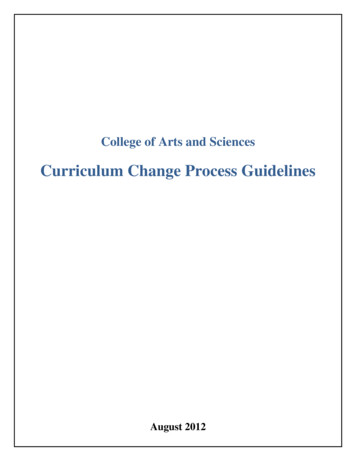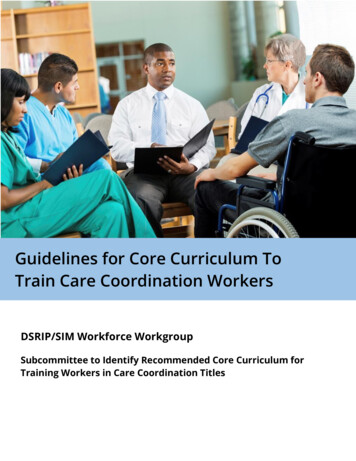
Transcription
College of Arts and SciencesCurriculum Change Process GuidelinesAugust 2012
2
Table of ContentsPAGEI.How to propose new undergraduate courses and changes to existing undergraduatecourses using the online course approval system, CREQA.Creating a proposal for a new course, without ACE certificationB.Creating a proposal for a new course, with ACE certification4-135-1010-13C. Making a change to an existing course13D. Requesting ACE certification for an existing course13E.II.Requesting Removal of ACE certification for a courseHow to propose a new major or minor13-14III.How to make changes to a major or minor14IV. How to propose or change a 900-level graduate seminar, or an 800-level coursethat does not have a 400-level componentV.Appendices:Appendix C – Curriculum Definitions (from University Curriculum CommitteeHandbook)Appendix D – Policies for Cross Listing of Courses (from UniversityCurriculum Committee Handbook)315
College of Arts & SciencesCurriculum Change Process GuidelinesAll curriculum proposals must be received from academic units by the Dean’s Office by the 20th of the month tobe considered at the following month’s College Curriculum Committee meeting (so to be considered for theOctober meeting, proposals must reach us by September 20). Please note that proposals for new courses withACE certification will take longer than non-ACE course proposals to work their way through the system (see“Flow chart for approval of curriculum proposals” on the Arts & Sciences website; click on “AdministrativeResources,” then “Curriculum.”)I. How to propose new courses and changes to existing courses using theonline course approval system (CREQ)The University’s Course Approval system (CREQ) is used for all new courses proposals, changes to courses,removal of courses and requests regarding ACE certification, recertification or decertification for anundergraduate course. Anyone with a Blackboard account has access to the system. Go to http://creq.unl.edu/and log in with your Blackboard user name and password. If you want to use the system but do not have aBlackboard account, please contact Mary Klucas (mary.klucas@unl.edu) for assistance.NOTE: CREQ does not have an automatic backup while creating a proposal and will time outif left too long. It is recommended that you copy the information from a MS Worddocument (or similar program) into the proposal to lessen the likelihood of losinginformation.There are several levels of approval before the proposal receives final approval. Those areSubmitter college curriculum facilitator university curriculum facilitator departmentapproval received by College Curriculum and Advising Committee (CCAC) UniversityCurriculum Committee (UCC)/ACE Subcommittee Graduate Studies.From start to finish it can take two to three months for a course to go through the approval levels provided therearen’t any revisions needed for the proposal. The need for revisions can add another month or two.CCAC approvals can be found at http://cas.unl.edu/ccac.shtml.University level approvals can be found at http://creq.unl.edu/, select UCC Activity. Approvals for the UCC,ACE Subcommittee and Graduate Council are all included in the same document. NOTE: This can be checkedwithout logging in to CREQ.4
A. Creating a proposal for a new course, without ACE certification: Select “new request” to start a proposal. NOTE: Any heading in red font is required. You will not beable to submit your proposal if the information is omitted. Screen 1: Fill in department code and proposed course number. Some departments use a letter aftertheir course numbers, for example ENGL 333A. If your department doesn’t use letters, then leave thatspace blank. NOTE: If you are creating a 400/800 level course, only insert the undergraduate number atthis point. Screen 2: Pick what action you want to take: Request a new course5
Screen 3: Making your request:1. Course ID:Prompts you for a course title.2. Crosslistings:This box allows you to request a cross-listing. If applicable, click on “cross-list” and add the departmentcode and number for the other unit (check with that unit to get a valid number). Also in this box is a promptfor “graduate tie-in;” click on it if you want to include an 800-level component with your 400-levelundergraduate course. This should automatically fill-in the 800-level component for you.3. Course Groups:This box allows you to add a course group. Currently, Anthropology, History, Mathematics, and PoliticalScience are the only departments in the college with these group/filters in place.4. Activity:Click on “add an activity,” then use the drop-down menu to choose the activity type. Regularclassroom courses are always at least partly Lecture (LEC) (which just means the class meets as a whole in aclassroom; it does not refer to a teaching method). If part of the course’s credit will be for a lab and/orrecitation section, click again on “add an activity” until you have added all components of your course.Hours per week: Enter the number of contact hours students will actually have per week for eachactivity. The total number of hours you list does not have to correspond to the number of credit hoursstudents will earn in the course; some labs, for example, are worth one credit hour but require more than onehour per week of student lab time. (For example, the Bulletin listing for BIOS 473/873 reads (4 cr) Lec 3,lab 4, meaning that students earn four credit hours in the course, but will spend three hours per week in theclassroom and four in the lab.)6
5. Credit hours:For regular courses, just fill in the number of credit hours in the “single values” space. The spaces for“range” and “Max per degree” only come into play if you are proposing a course that receives variablecredit, such as an independent study course or an internship. (See Appendix C for further information.)Terms offered: Leave all of them checked unless you are certain your unit will NEVER offer the courseduring a particular term. Once you uncheck a term you CANNOT offer the course that semester.6. Prerequisites:Enter any prerequisites for your course here. If there are no prerequisite leave it empty.7. Notes:Notes should include any special information students need to know that is not part of the coursedescription. (For example, Geography 140, Introduction to Human Geography, has a note reading,“Students who have previously taken GEOG 100 may not receive credit for GEOG 140.”) Most courses donot have a note, so don’t put one in unless you think it is necessary.7
8. Description:The description here is for the Bulletin. It should be a short summary of what the course will coverregardless of changes in instructor. Bulletin conventions include the use of brief descriptive phrases ratherthan complete sentences. Do not include lists of assignments or descriptions of the unit’s teachingphilosophy. The course description identifies what is to be covered rather than how a course will be taught.For example, ENGL 245J, Jewish-American Fiction: “Twentieth century novels and short stories by majorJewish-American authors.”9. Additional Information:Grading: For regular classes, check “unrestricted,” meaning that students can normally choose whetherto take the course for a grade or pass/no pass (subject to University, College, and department rulesgoverning how many pass/no pass hours they can count toward graduation). If you do not want students tohave the pass/no pass option, check “grade only.” Many departments offer internships on a pass/no passbasis only. It is recommended to add a statement in the “Note” box above if a course is letter grade only orpass/no pass only.Delivery methods: Check all that apply.Campuses: Check all that apply. Most courses will be UNL only.ACE/IS/ES Status: These boxes cannot be selected by submitter.Term effective: The system will automatically list the earliest date the proposal can be effective. You havethe option to select future terms. If you are making significant changes to a course (especially in coursenumber and/or course title) we recommend that the effective date be set for the following fall to allow forthe changes to be programmed in DARS and to avoid confusion when students are registering for classes.In fact, the College Curriculum and Advising Committee may request an effective date consistent with thenext year’s bulletin if it foresees problems with making the change immediately.8
10. Justification:Explain how the new course fits into the department and College curriculum and its potential impact on themajor and/or minor. A short paragraph is ample.11. Required Materials:Syllabus: The syllabus should include a list of texts and equipment to be used in class, course requirements(exams, papers, lab projects, presentations, etc.), information about how grades will be determined, andUNL’s statement on accommodations for students with disabilities. (See www.unl.edu/svcaa/teaching@unlfor UNL’s syllabus policy.) Include a grading scale and a list of papers, exams and other assignmentsthat will contribute to the students’ grades, along with the exact or approximate value of thoseassessments, either in points or percent of total grade. For 400/800-level courses, indicate the differentor additional work graduate students will complete.12. Supportive Material:Cross-list memo: If you plan to cross-list your course, upload a letter or e-mail from the otherdepartment giving their permission for you to do so. You must also have a letter of permission if youmake another department’s class a prerequisite for yours.9
Additional documentation: Please upload a resource analysis (form AS3) here which is required forall new courses. The form can be found on college website at http://cas.unl.edu/adminresources.shtml. Ifyou click on "curriculum" it will open the drop-down menu of curriculum items.Click on “preview” to view a summary of your proposal, then “send.”B. Creating a proposal for a new course, with ACE certification:The process begins the same as creating a proposal for a new course without ACE certification. On thesecond screen select “Request new course with ACE Certification.”The request will be the same as creating a proposal for a new course without ACE certification until youget to the ACE Certification box. You will be asked to select one or more learning outcomes, thenanswer a series of questions about how students will meet each outcome you choose. Most coursesare certified for only one outcome, although a fair number are certified for two. For examples ofsuccessful proposals, see the Office of Undergraduate Studies’ ACE website, http://ace.unl.edu/.Regardless of the SLO selected you will need to provide responses for the following questions:1. Describe opportunities students should have to learn the outcome. How is the learning objectiveembedded in the course?2. Describe student work that will be used to assess student achievement of the outcome and explainhow the students demonstrate the knowledge and skills specified by the outcome.3. As part of the ACE certification process, the department/unit agrees to collect and assess areasonable sample of students’ work and provide reflections on students’ achievement of theLearning Outcomes for its respective ACE-certified courses. Please comment on your plans todevelop a process to collect and evaluate student work over time for the purpose of assessingstudent success for this ACE outcome.NOTE: It is suggested that the responses for the ACE questions be composedin a MS Word document (or a similar program) and then copied intoCREQ as there is no automatic backup in CREQ while a proposal isbeing created. This way there is no lost information should CREQtime out during the creation of a proposal.10
11
12
You will also be asked to select the outcomes or skills which the course will reinforce. For each oneyou select, you will be prompted to write a brief description of how it will be reinforced. There is noneed to pick more than one or two reinforcements.Please note that the outcome and the reinforcement cannot be the same, so outcome 1 courses cannothave a writing reinforcement, outcome 2 courses cannot have visual or oral communication asreinforcements, etc. For outcome 5, humanities, you cannot use critical thinking as a reinforcement,since the outcome already calls for critical thinking.According to the ACE document (#4) the syllabus submitted for an ACE course must include thefollowing so that students understand what they are supposed to learn:1. The Learning Outcome(s) that would be satisfied by the course. (SLO language verbatim)2. A brief description of the opportunities this course would provide for students to acquire theknowledge or skills necessary to achieve the Learning Outcome(s)3. A brief description of the graded assignments that the instructor(s) will use to assess the students'achievement of the Outcome(s).C. Making a change to an existing course:You can change any of an existing course’s characteristics as described above. The one differentcomponent is under “Additional Information,” the option marked “DF removal.” If you check“yes,” students who took the old version of the course can retake the new version to remove a D or F. Ifyou check “no,” they cannot. Most new versions of courses do permit D and F removal.Your justification should address each change to the course. If you are changing course level, be sure toindicate how you will alter the content and assignments to fit the new level.D. Requesting ACE certification for an existing c ourse:Click on “ACE certification only;” you will be prompted to choose learning outcomes and answerquestions about them as described above. You do not need to submit a new resource analysis.E. Requesting removal of ACE certification for an existing course:Click on “Removal of ACE Certification for this course.” A letter of approval from the Associate Deanfor Academic Programs must be obtained to complete this type of proposal.II. How to propose a new major or minorWhile this kind of curriculum action may be moved to CREQ in the future, it is currently a paper-basedproposal.13
A. MajorFollow the guidelines laid out in the Academic Planning Committee Guidelines for the Submission ofProposals for New or Modified Program and the Coordinating Commission for PostsecondaryEducation information can be found there as well. Both documents can be found athttp://www.unl.edu/apc/documents.shtml).In addition to the above mentioned proposal please submit the following items for review by the CollegeCurriculum and Advising Committee and the college faculty. Forms are available on college website athttp://cas.unl.edu/adminresources.shtml. If you click on "curriculum” it will open the drop-down menuof curriculum items.1. Form AS1, Arts & Sciences cover sheet;2. Complete, Bulletin-ready text of the major. Please use the Major Page Submission Template guide;3. Justification statement;4. Letters of permission from any other units affected by the changes (for example, if your unit isinterdisciplinary and you add courses from other units to your requirements, you will need letters ofpermission);5. Submit the proposal to the Dean’s Office as a hard copy;6. Email an electronic version of the proposed Bulletin copy and your justification as attachments toMary Klucas, mary.klucas@unl.edu.B. MinorIn addition to the above mentioned proposal please submit the following items for review by the CollegeCurriculum and Advising Committee and the college faculty. Forms are available on college website athttp://cas.unl.edu/adminresources.shtml. If you click on "curriculum” it will open the drop-down themenu of curriculum items.1. Form AS1, Arts & Sciences cover sheet;2. Complete, Bulletin-ready text of the major. Please use the Major Page Submission Template guide;3. Justification statement;4. Letters of permission from any other units affected by the changes (for example, if your unit isinterdisciplinary and you add courses from other units to your requirements, you will need letters ofpermission);5. Submit the proposal to the Dean’s Office as a hard copy;6. Email an electronic version of the proposed Bulletin copy and your justification as attachments toMary Klucas, mary.klucas@unl.edu.III. How to make changes to a major or minorWhile this kind of curriculum action may be moved to CREQ in the future, it is currently a paper-basedproposal. Forms are available on college website at http://cas.unl.edu/adminresources.shtml. If you click on"curriculum” it will open the drop-down the menu of curriculum items.A. Form AS1, Arts & Sciences cover sheetB. Copy of text in bulletin with all changes highlighted, for deletions use strikethrough and for additionsuse underline. Contact Mary Klucas, mary.klucas@unl.edu and she will provide you with a MSWorddocument of the current on-line bulletin listing for your major and/or minor to work from.C. Justification statement addressing each changeD. Letters of permission from any other units affected by the changes (for example, if your unit isinterdisciplinary and you add courses from other units to your requirements, you will need letters ofpermission).E. Submit the proposal to the Dean’s Office as a hard copy.F. Email an electronic version of the proposed Bulletin copy and your justification as attachments to MaryKlucas, mary.klucas@unl.edu.14
IV. How to propose or change a 900-level graduate seminar, or an 800-levelcourse that does not have a 400-level componentArts & Sciences is using the Course Approval System (CREQ) for graduate only courses as well. Please followthe above instructions for Creating a proposal for a new course, without ACE certification or Making achange to an existing course.The routing for approval in CREQ is a bit different for graduate-only courses. It is as follows:submitter college curriculum facilitator graduate studiesThere is no department approval level so please be sure to gain approval from your department prior tosubmitting the proposal in CREQ.15
APPENDIX C from University Curriculum Committee HandbookCurriculum DefinitionsCompiled and Prepared by Gail Hackwith, Undergraduate StudiesContributed/Reviewed by Tony Schkade, Registration and RecordsReviewed by Earl Hawkey, Registration and RecordsUpdated by Brooke Glenn, Undergraduate EducationReviewed by Keith Dawson, Registration and Records1. Activity Type – all courses must have at least one activity type. Lecture (Lec) – can have a maximum of 2 co-activity types. Always has credit hrs.o Possible combination: Lec, Lec/lab, Lec/rct, Lec/quz, Lec/lab/quz, Lec/lab/rct,Lec/rct/quzLaboratory (Lab) – must have credit hours if the letter “L” is in the last position of thecourse number. If Lab is in combination with another activity type, Lab will not have credithrs.o Possible combination: Lab, Lec/lab, Lec/lab/quz, Lec/lab/rctQuiz (Quz) – always taught with Lec. Never has credit hours.o Possible combination: Lec/quz, Lec/lab/quz, Lec/quz/rctRecitation (Rct) – Always taught in conjunction with Lec. Never has credit hours.o Possible combination: Lec/rct, Lec/rct/lab, Lec/rct/quzStudio (Sdo) – Always has credit hours. Stand alone activity.Field (Fld) – Course taught in the field and generally taught off campus. Always has credithrs. Stand alone activity.Independent Study (Ind) – Topic not covered in any other course at the University. Ind isnot course offered by special study arrangement. Always has credit hours. Stand aloneactivity.Personalized System of Instruction (PSI) – Sometimes called “self-paced or Keller Plan”.Always has credit hours. Activity can be called Lec or PSI.2. Course Numbering The numbering system was established by the Board of Regents in September 1971.Numbers in the University of Nebraska Course Numbering System have specificdefinitions: 00-99 -- special, noncredit, prerequisite, short-term, or special graduate courses. Zerocredit hours and Pass/No Pass cou
6. Prerequisites: Enter any prerequisites for your course here. If there are no prerequisite leave it empty. 7. Notes: Notes should include any special information students need to know that is not part











